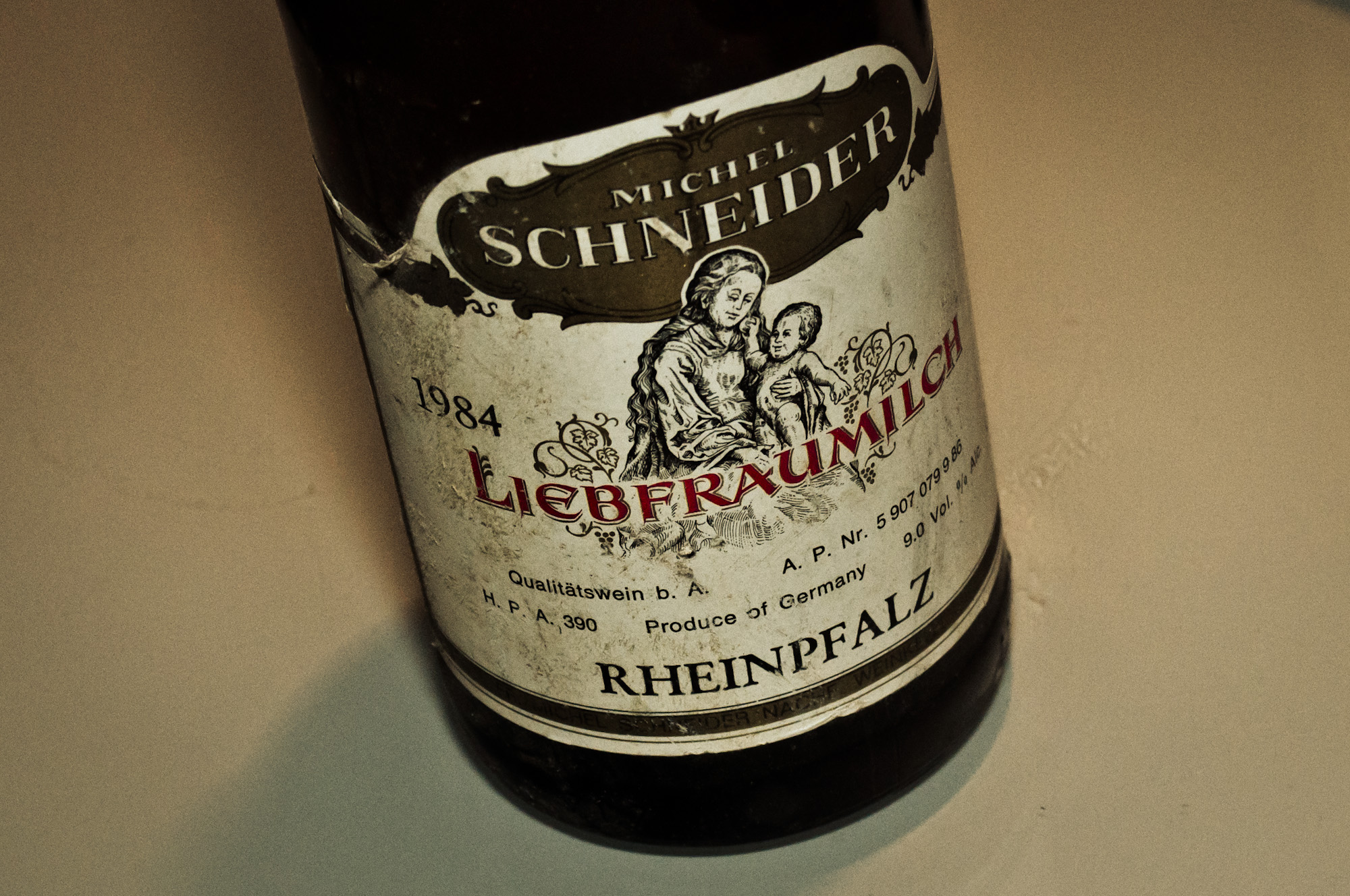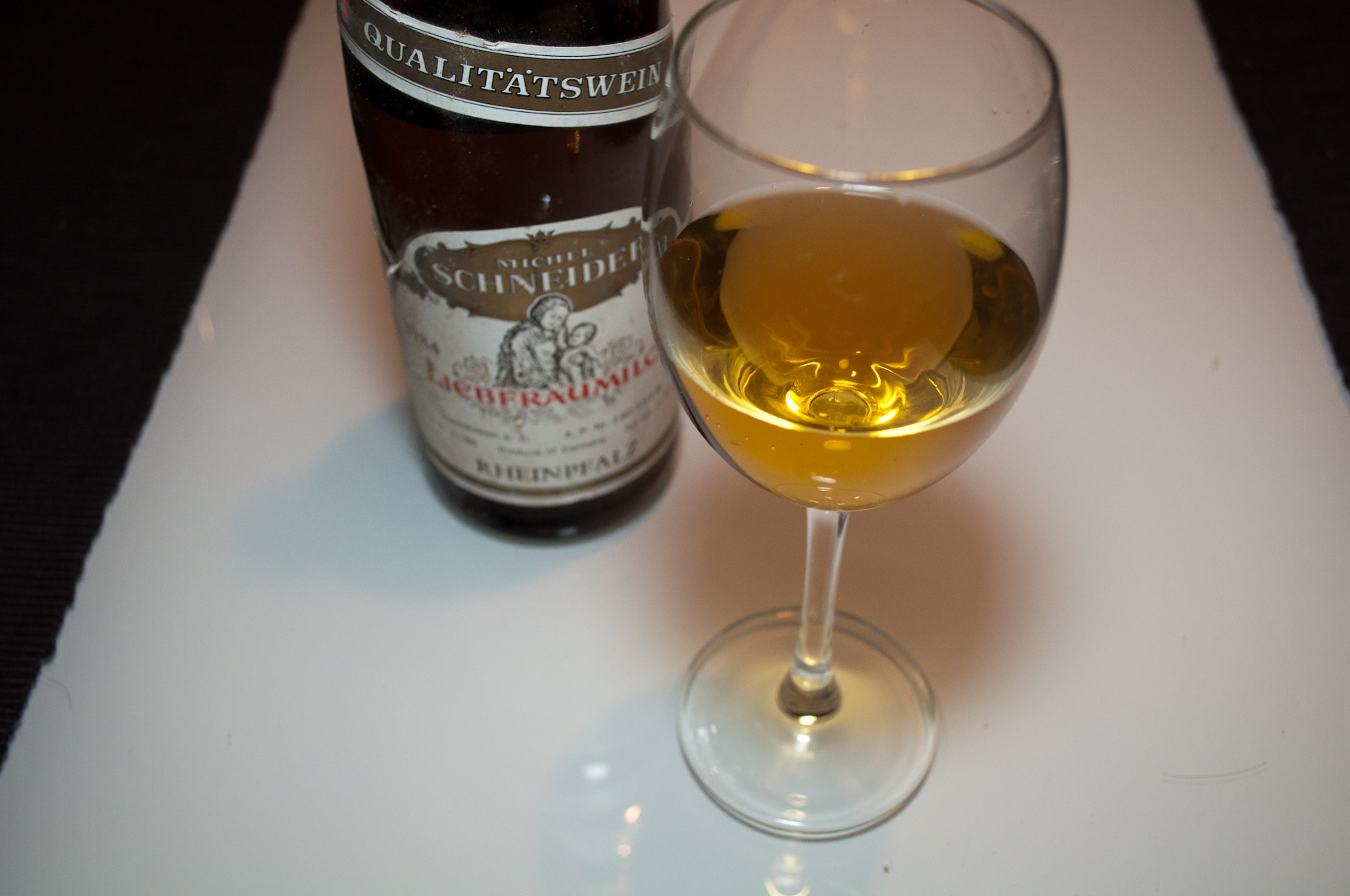Michel Schneider, Liebfraumilch Q.b.A., 1984
Liebfraumilch does not need much introduction, seeing as it is probably the wine most foreigners, certainly the British, associate with Germany. What hundred years ago was one of the best white wines in the world has since become cheap supermarket plonk. Hardly a reason to look out for those wines then, I hear you say - and yet I got extremely excited when a little while ago I got my hands on a bottle. Why? Because it was over 25 years old.

At this age, most wines are undrinkable, and even quite a few age-worthy white wines don't look exactly fresh anymore. Surely, the Liebfraumilch must have turned into vinegar. Or did it?
The when, where and how I got my hands on this wine will be explained later. For now let me just say that with a some friends I sat around a table, carefully pulling the cork out of a bottle none of us knew the origin of.
What we found was a wine of relatively dark colour, a gold, intense yellow with a touch of red brick and metal-brown, only slightly lighter round edges. This was highly unusual as I had expected the Liebfraumilch to be much more on the redish side, seeing how old it was. It got even more unusual when we put our noses into our glasses. And smelled, well, certainly not vinegar. Instead we encountered a somewhat buttery wine, with aromas of linseed oil and cough sweets, a little smoky and earthy, clearly oxidised and with light petroleum notes, but still enough fruit left to pin down Bramley apple.

Encouraged by the bouquet, we tasted the wine. And to our surprise it was still drinkable. The finish had a hint of not so exciting bitterness, an impression that was enhanced by a certain smokiness, like grapefruit just without the fruit flavour. Even so, the Liebfraumilch still had flavours of lemon and apple with a bit of dusty grapefruit and liquorice aromas. Faded into the background also was a hint of sweetness, but aged away - "no longer sweet, but not unsweet", as one of my friends put it.
I won't tell you that the Liebfraumilch objectively was a great wine, but it was certainly still service- and drinkable. In fact we were so pleasantly surprised by a wine that by all rights should have been dead that we pretty much finished the bottle. It was an interesting lesson in how wine can sometimes surprise you with its ability to age, and how a surprise can make a wine feel special that, had we seen a recent vintage in a supermarket, we would not even have touched.

Comments
Wines do really taste better
Wines do really taste better when it's older. More interesting taste comes when it's older.
Hair of the dog?
I can still remember a particularly vicious hangover that occurred as a result of drinking Liebfraumilch at a teenage party - coincidentally enough, almost 25 years ago. If only I'd thought to let the wine age before I poured it into a plastic cup and gulped it down with a Strongbow chaser and a packet of Golden Wonder crisps...
In reply to Hair of the dog? by Muzuhashi
Liebfraumilsch
Wasn't Liebfraumilsch a specific vineyard before it became the generic brand we know today? Not sure when the change happened, but it might explain why this wine was still alive..
In reply to Liebfraumilsch by Vimpressionniste
Liebfraumilch
Thank you all for your comments. It is correct that there is the "original" Liebfraumilch vineyard in Worms, that goes back to at least the 18th century and had an excellent reputation. Sadly, the wine we had is not from there - these days Liebfraumilch is made in several wine growing region and can be made from a range of grape varieties. If the wine is labelled as "Liebfraumilch", classified as QbA and just has a region, such as "Rheinhessen", as origin you are looking at the mass produced variety. This is what made it so interesting that the wine was still in a serviceable condition.
Muzuhashi: perhaps parents should do this as a service for their children - put a few cases of Liebfraumilch away when the child is born and store them with your advice on how to drink it for when the child reaches drinking age? That would make for a much more civilised binge experience!
The when, the where and the how...
... are now finally revealed in this astonishing piece of investigative journalism.